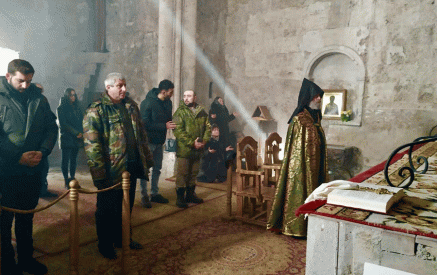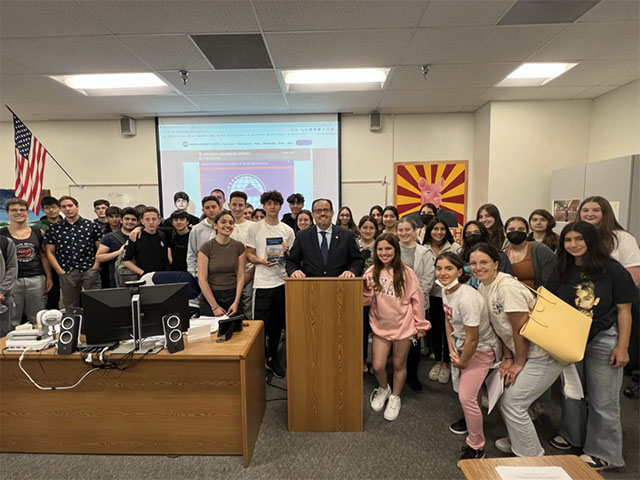By Karine Armen
Special to the Mirror-Spectator
ALTADENA, Calif. — David Karamian presented his photography book, Armenia – The Lone Stone: Invincible through the Ages, on Friday, May 10, at the Tekeyan Cultural Association (TCA) Beshgeturian Center here. The author and presenter is the founder and CEO of NorArtGallery Publishing (https://www.norartgallery.com/).
Organized by the TCA Metro Los Angeles Chapter, its board member, Mihran Toumajan, welcomed the audience and recounted the guest presenter’s biography. Karamian’s career spanned over thirty years in design systems and consulting for Fortune 10 companies. Karamian merged his passions for art, architecture, and history into his latest creation, Armenian – The Lone Stone, unveiled in September 2022. Toumajan added, “David’s dedication to his craft extends beyond the pages of his book. He’s a notable contributor to Black and White Photography Magazine and Scene4 Magazine. He is also an affiliate of UNESCO, a platform that showcases his commitment to cultural preservation and promotion.”
Read also
Karamian’s Armenia – The Lone Stone is a hardcover coffee table book consisting of 358 pages of text and poetry, and color and black-and-white photographs printed on the highest-quality paper. The photos of the monasteries and monuments in Armenia and Artsakh were taken from 2005 to 2022 during Karamian’s repeated visits. The text is in English and Armenian. It includes poems from Sayat Nova, Komitas, Silva Kapoutikyan, and several other notable poets. He also includes paintings by Armenian artists and attributes them to wikimedia.org.
Karamian started the event by explaining how he added his family history to a photography book. “Without my family background, it would have been another book about Armenia. This way, I wanted to make it unique and show who I was.” Karamian’s digital presentation was well-organized. He had the presentation’s outline and objective posted on an initial slide. His book encompasses 24 sections. While covering the first 12 sections, Karamian showed slides while the audience listened to Armenian instrumental music. Later, he highlighted the second half of his book and stated: “I don’t want to focus only on the [Armenian] Genocide. The world can learn about our rich history, literature, and music.” He emphasized, “I want non-Armenians and the new generation to know about our rich culture.”
Karamian was born in Tehran and grew up in an Armenian family. He learned about Armenian history from a substitute teacher in second grade. Ever since Karamian was a child, he dreamt about visiting Armenia. Finally, in 2005, he visited his homeland. Feeling deeply touched by his experience, he photographed several churches, monasteries, and historical monuments and buildings. Karamian is a mechanical engineer with a passion for the arts. He uses his camera to capture the beauty of his homeland. By publishing his hardcover book, Karamian was able to thoughtfully weave his personal story with striking images of cultural treasures in his homeland. Storytelling is, after all, a form of art.
Karamian’s photographs match the mood of their respective settings. His pictures in Gyumri have dark gray tones. The white Ghazanchetsots Cathedral in Shushi is juxtaposed with a gray sky, and the photos of the paintings inside the church are in bold colors. Capturing the mountains and valleys in black-and-white has created intense texture, negative shapes, contrast, and lines. The Garni Temple is shot from different angles in black-and-white, emphasizing its architectural strength and beauty. One needs to look intently to notice them.
The book’s accompanying text is well-researched. It can serve as an academic study of the location or as an inspiration to travel. Each chapter starts with detailed information about the place, as well as the church, monument, or structure. Yerevan’s Matenadaran – the Mesrop Mashtots Research Institute of Ancient Manuscripts – is displayed with an initial photo of the building, while ensuing photographs show each statue, in detail, surrounding the museum. Karamian uses color for the photos of the Dadivank Monastery, Sardarapat Memorial, and Karahunj (Zorats Karer), which have brown, yellow, and orange hues juxtaposed with blue sky. The author/photographer is well aware of complementary colors in art.
During a brief question and answer session, Toumajan encouraged Karamian to contact Caucasus Heritage Watch (https://caucasusheritage.cornell.edu/) and share his photographs of churches, monasteries, museums and monuments taken while exploring Artsakh. Another member of the audience asked Karamian if his book was a combination of art and memoir. The author responded that while the preface of the book included his family’s history, he did not consider it a memoir. Karamian is currently working on a second volume of Armenia – The Lone Stone, in addition to a book highlighting his abstract photographs.
Armenia – The Lone Stone is a well-designed book. At first glance, it might seem overwhelming. By studying it mindfully, one can appreciate its value.




























































